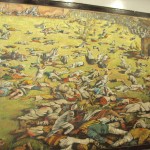Salam was back after a month at his blog in an internet café in the war torn Baghdad. Two new blogs had started reporting in that time: Baghdad Burning and Healing Iraq. Ironical, for they were reporting on the same times and from the same place.
Salam Pax was, unbeknownst to himself creating history. He was chronicling the US Invasion of Iraq in 2002 and the subsequent occupation in anonymity. He was reporting on these events from a standpoint that no one had. And in almost real time. As the war unfolded, Salam went onto give his sometimes witty, sometimes angry and sometimes opinionated viewpoints but interesting nevertheless. Even the popular media journalists used his weblog (blog) as a news source to understand the situation on the ground.
Citizen Journalism from a war zone had met with the power of technology to take the information that was created on the field to the top news channels within minutes.
Such attempts of normal people to write about events of historic proportions had been done before in 1942, like when Anne Frank, the 12 year old Jewish girl from Achterhuis started writing the diary of her and her family’s attempt at hiding from the anti-semitic Nazi violence. She died in early March 1945 but in just two years had created a compelling piece of writing in her diaries later published as “Het Achterhuis” (later translated as “The Diary of a Young Girl”), a book that brought out the “hideousness of fascism” in a child’s voice.
“What became of our forces which held the bridge till twenty minutes ago…? ” was the first message sent to his troops using telegraph in the Civil War by Abraham Lincoln. The new lines had been laid down by the then Superintendent of the Military Railways and the Union Government’s telegraph lines in the East, Andrew Carnegie. From using human messengers to carry the information of latest events in the war between the commander and the troops, technology of communicating over large distances had been now used for the first time to radically alter the way in which wars would be conducted in future.
Salam Pax and his blogging friends, had the soul of Anne Frank and zeal of Abraham Lincoln as they, for the first time in human history, chronicled a war in real time from the eyes of the victims using Internet.
This gang of four (“G”, Salam Pax, “River”, and Zeyad) also changed the face of journalism as it had existed until then. A group of high brow people steeped in proper English and grammar. The local and indeed spontaneous lingo became the vernacular of the masses. In one small step to the Internet Café of Salam Pax, the world took a giant leap in the world of journalism and war communication.
References (Footnotes):
• Mr. Lincoln’s T-Mails: The Untold Story of How Abraham Lincoln Used the Telegraph to Win the Civil War (HarperCollins, 2006) ; by Tom Wheeler
• Kinderstem (A Child’s Voice), written by the historian Jan Romein (http://www.annefrank.org/content.asp?pid=112&lid=2)
• Blogs on Iraq: Site 1 . Site 2 . Site 3 . Site 4











